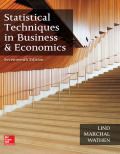
Concept explainers
a.
Compute SSE.
a.
Answer to Problem 46CE
The sum of squares due to errors is 603.99.
Explanation of Solution
It is given that the total sum of square is 1,099.61.
The sum of squares due to errors can be obtained as follows:
Thus, the error sum of squares is 603.99.
b.
Determine SST.
b.
Answer to Problem 46CE
The sum of square due to treatments is 495.62.
Explanation of Solution
The sum of square due to treatments is given below:
The sum of square due to treatments is 495.62.
c.
Construct an ANOVA table.
c.
Answer to Problem 46CE
The complete ANOVA table is as follows:
| Source of variation | Sum of Squares | Degrees of freedom | Mean Squares | F-statistic |
| Treatments | 495.62 | 3 | 165.207 | 9.847 |
| Error | 603.99 | 36 | 16.778 | |
| Total | 1,099.61 | 39 |
Explanation of Solution
There are four radio stations in Midland, and a sample of 10 randomly hours from each station is selected.
Degrees of freedom:
The degrees of freedom for treatments
The total degrees of freedom
The degrees of freedom for error
Mean sum of squares:
The mean sum of squares can be obtained by dividing each sum of squares by its respective degrees of freedom.
The mean sum of squares for the treatments can be calculated as shown below:
The mean sum of squares for error can be calculated as follows:
F-Statistic:
F-statistic is the ratio of mean square for the treatments to the mean square error.
The ANOVA table and computed F value are given below:
| Source of variation | Sum of Squares | Degrees of freedom | Mean Squares | F-statistic |
| Treatments | 495.62 | 3 | 165.207 | 9.847 |
| Error | 603.99 | 36 | 16.778 | |
| Total | 1,099.61 | 39 |
d.
Find whether there is a difference in the treatment means.
d.
Answer to Problem 46CE
There is a difference in the treatment means.
Explanation of Solution
The null and alternative hypotheses are stated below:
There are four treatments; thus, the numerator degrees of freedom
There are 40 observations; thus, the denominator degrees of freedom
From appendix B.6A, at the 0.05 significance level, the F-test critical value is 2.88.
Decision rule:
Reject the null hypothesis if the computed F test statistic value is greater than the critical value. Otherwise, fail to reject the null hypothesis.
Conclusion:
The F-test statistic value is greater than the critical value at the 0.05 significance level. One can reject the null hypothesis at the 0.05 significance level.
Therefore, there is a difference in the treatment means.
e.
Find whether there is a difference in the means of hard rock station and country/western station at the 0.05 significance level.
e.
Answer to Problem 46CE
There is no difference in the means of hard rock station and country/western station.
Explanation of Solution
The null and alternative hypotheses are stated below:
It is given that the mean for the hard rock station is 51.32 and the mean for the country/western station is 50.85. The sample size of each station is 10. The mean square error is 16.778.
That is,
From Appendix B.5, the critical value of t with 18 degrees of freedom is 2.101.
The 95% confidence interval for the difference in the means is given below:
Conclusion:
The confidence interval for the difference in the means of hard rock station and country/western station includes zero. Thus, the two means are not significantly different.
There is no difference in the means of hard rock station and country/western station.
Want to see more full solutions like this?
Chapter 12 Solutions
EBK STATISTICAL TECHNIQUES IN BUSINESS
 Glencoe Algebra 1, Student Edition, 9780079039897...AlgebraISBN:9780079039897Author:CarterPublisher:McGraw Hill
Glencoe Algebra 1, Student Edition, 9780079039897...AlgebraISBN:9780079039897Author:CarterPublisher:McGraw Hill Functions and Change: A Modeling Approach to Coll...AlgebraISBN:9781337111348Author:Bruce Crauder, Benny Evans, Alan NoellPublisher:Cengage Learning
Functions and Change: A Modeling Approach to Coll...AlgebraISBN:9781337111348Author:Bruce Crauder, Benny Evans, Alan NoellPublisher:Cengage Learning

